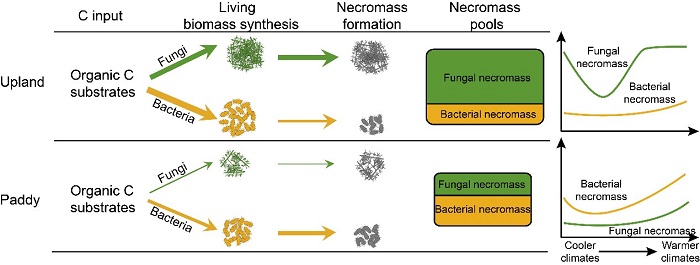Stronger Carbon Sequestration in Paddy Soils than Adjacent Upland Counterparts
Increasing carbon sequestration in agricultural soils is beneficial to promote crop productivity and combat climate change. Paddy and upland lands are the general land-use types of agroecosystems. Researchers led by Prof. Chen Xiangbi from the Institute of Subtropical Agriculture of the Chinese Academy of Sciences (CAS) previously demonstrated that compared to their nearby upland soils, paddies were 39%–127% more effective in organic carbon sequestration, with greater differences in warmer than cooler climates.
In their most recent studies published in Soil Tillage and Research on Jan. 1 and Catena on Feb. 23, the researchers have elucidated the underlying mechanism of greater carbon sequestration in paddy than upland soils from the perspective of microbial metabolism for old carbon and fresh carbon.
Forty pairs of paddy and upland soil were randomly selected to determine total microbial growth, respiration, and C use efficiency by the 18O water incubation. Compared to upland soils, higher growth efficiency and lower respiration were found in paddy soils, inducing greater C use efficiency and thus reducing soil carbon release to atmosphere.
In addition, paired paddy and upland soils were incubated with 13C-labeled root exudates under standard condition for 50 days to quantify microbial anabolism and necromass formation. 13C-substrates derived living microbial biomass was 1.4–2.6 times higher in upland than paddy soils, leading to 1.8–3.9 times greater accumulation of 13C-substrates derived microbial necromass in the former. These findings imply weaker accumulation but stronger stability of organic C in upland than paddy soils attributed from intensive microbial catabolism and anabolism.
“Vast incorporation of microbial transformed and stabilized organic materials may be effective to promote organic C sequestration potential in upland soils, while maintaining flooding in paddy soils would be important to avoid C loss via microbial mineralization,” said Prof. Chen Xiangbi.
These studies were financially supported by the National Natural Science Foundation of China and the National Key Research Program of China.
Contact: Chen. Xiangbi
E-mail: xbchen@isa.ac.cn

Diagram illustrating the differences of living microbial biomass synthesis and necromass formation from “fresh carbon” in water-logged paddy versus well-drained upland soils across eastern China (Imaged by Xun Duan).
Download attachments: